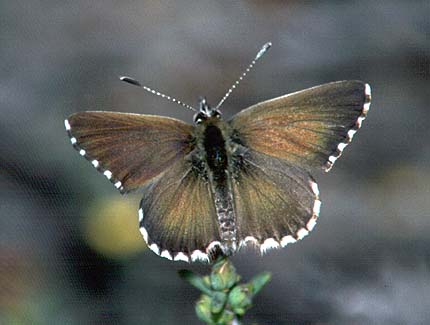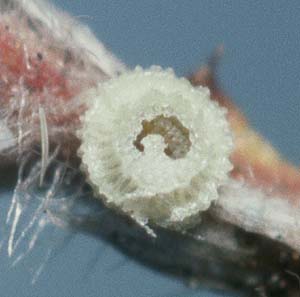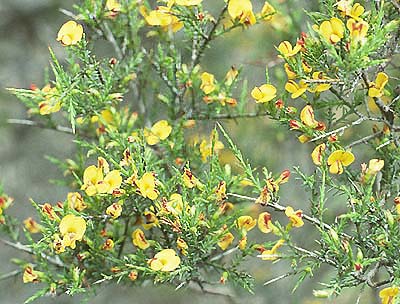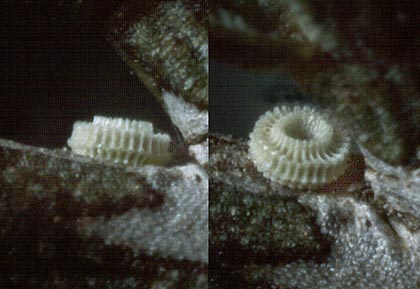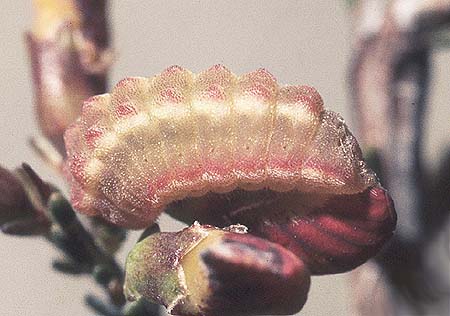-
Larval Food Host
-
Various small bush-pea plants including Aotus species, Bossiaea spp,
Daviesia spp (bitter-peas), Dillwynia spp (parrot-peas) including
D. sericea (showy parrot-pea), Eutaxia spp including
E. microphylla (mallee bush-pea), Pultenaea spp including
P. acerosa (bristly bush-pea),
P. densifolia (dense bush-pea),
P. largiflorens (twiggy bush-pea),
P. tenuifolia (narrow-leaf bush-pea) (Fabaceae).
The larvae eat the buds and flowers, and sometimes the young leaves and young pods of
the hostplant. The preferred hostplant in South Australia is Eutaxia microphylla,
which tends to grow in mallee and dry habitat. In moist habitat along the South Mt Lofty
Range the butterfly will use Dillwynia sericea and Pultenaea largiflorens.
-
Larval Attendant Ant
-
Larvae are sometimes attended by a few small dark brown and black ants
Iridomyrmex species. However ants are not an
obligate necessity, and often the larvae become agitated with ants around
and will attempt to dislodge them if they actually crawl onto the larvae.
-
Eggs
-
Small, initially pale green, later turning white, shaped like a cogwheel, flattened
top and bottom. There are essentially four major, horizontally stacked circular
ridges, which intersect with numerous vertical ridges. Coarse, blunt projections are
produced at the pattern intersections. There is a reduced basal ridge, and two large,
equal sized horizontal central ridges (the outer edge of the cog wheel), while the
uppermost row is much reduced in extent and is closer to the micropylar area. The
reticulation facets on the edge of the egg are deep, and rectangular shaped. The
bottom of the egg has very fine hexagonal reticulations. The top central part of
the egg is not ridged and is deeply depressed, and also has fine reticulations that
are mostly hexagonal shaped, which continue to the micropylar area in the centre of
this depressed area.
Laid singly on new hostplant growth in the outer parts of the plants, often wedged into
the crevice between two branching stems, but also in other crevices within the bark of
the hostplant in its outer parts. This position would provide protection from rain and
wind induced rubbing movements, but those eggs laid in the crevice between two stems
could be dislodged in late winter by newly developing bud growth. The eggs can also be
laid along the stems but these eggs are not protected, although the cementing or gluing
medium at the base of the egg is very strong. Larva development occurs immediately
after the egg is laid, but once developed the larva (and egg) then diapauses (becomes
dormant) until the following late winter and early spring when the larva hostplants
start to flower. The trigger for egg hatching is probably due to an increase in daylight
hours and additional day warmth after winter, although there may also be a genetic
time-clock component as well. The larvae do not always synchronise their emergence
with the flowering of the hostplant and those that emerge too early have to survive on
young leaves and green-buds until the flowers develop. In Australia, the unusual egg
shape is confined to the genus Neolucia and the shape is unique to this genera
of butterflies. (It may be the optimum shape for eggs that undergo a hot summer and
cold winter dormancy period, to stop them from collapsing.)
-
Larvae
-
The first instar is onisciform shaped, initially pale yellowish grey or brown, with a large
pale brown coloured prothoracic plate. There is an indistinct dorsal furrow, and there are
transparent peripheral setae (hairs) that are directed downwards. These hairs are slightly
flattened and have distinctly blunt ends. There are paired, very short transparent dorsal
setae on each segment that are flattened and club shaped, and which are flattened against
the body and directed posteriorly, and they also become slightly larger posteriorly. The
head is large, exposed, and black coloured. (The first instar is remarkably similar to that
of Nacaduba biocellata, even though the
adult butterflies look completely different).
As the larvae increase in size, they acquire multicolours, and dorsal protuberances, which
become more developed with maturity. They can change their colour during their lives such
that a green coloured larva can become orange or brown after a moult. The larvae gradually
lose any dorsal and lateral hairs, and the head eventually changes to a brownish yellow
colour by about the fourth instar.
The mature larvae are about 11-13 mm long. Dorsally furrowed, with short blunt paired
protuberances on thoracic segments 2-3 and abdominal segments1-6, that are widely
spaced near the head, but gradually come together towards the posterior end. The
lateral edge of the larva is weakly scalloped. The head is small, smooth, brownish
yellow, hidden beneath the body. The body has some short, anterior and posterior
hairs. It is covered in numerous tiny secondary setae having a stellate base (about
8 spines) and a long protruding serrated and pointed central (usually curved) spine.
These setae are coloured and contribute to the colour pattern of the larva. The larvae
are polymorphic (i.e. they occur in many colour forms). Larvae colour and markings are
highly variable and picturesque, with the predominant colour being either green, pale
brown, or orange-red. The colours become dull near the point of pupation. There is
always a narrow dark longitudinal dorsal line, and a white lateral line that extends
from thoracic segment (TS) 2 to the anterior edge of the last abdominal segment (AS).
The white lateral line is usually broadly edged with red dorsally. There is a broad
continuous pale (white or yellow) subdorsal line extending from TS 2 to AS 6, but which
becomes indistinct posterior of AS 6. On the posterior edge of TS 1 the white lines are
joined by a narrow black or dark red line. The summit of each dorsal protuberance is
usually marked red. The anterior part (TS 1) of the larvae is sometimes noticeably red,
and there is sometimes a further indistinct white longitudinal line between the white
lateral and subdorsal lines. The larvae colours are cryptic and blend in with the buds,
flowers and stems of the hostplant, such that the larvae are virtually invisible to the
human eye.
Larvae feed openly during the day as well as at night. The larva is immobile when feeding
on the flower bud. When immature it eats a small hole into the side of the bud, then
progressively inserts its head (and sometimes the forward part of its body) into the bud
and gradually eats out the stamen contents until the bud is reduced to an empty shell.
The larva then becomes mobile again as it moves to the next bud. Larger larvae will
completely envelop the bud with the forward part of its body before eating the entire bud.
Young shoots and pods are also sometimes eaten when the buds are in short supply. The larva
stage lasts about 4 weeks.
The presence of larvae on a hostplant is discernible by holes in the flower buds and flowers,
or by the complete loss of the buds, and sometimes by the presence of small ants. The flowers
of the hostplants harbour many small bug and spider predators, and it is likely many of the
immature larvae get eaten. Larvae are also prone to parasitisation by large flies, which usually
have destroyed the larvae by the fourth instar.
-
Pupae
-
Short cylindrical, about 8-10 mm long, rounded anteriorly and posteriorly, with short
pale bristles on the head, thorax and abdomen. Occurs in shades of brown, grey-brown,
orange-brown or yellowish-brown, with the colour being generally dependant on the
substrate or the initial larva colour. The wing areas tend to be greyish. Very finely
speckled with dark brown markings, and there is a dark brown longitudinal dorsal line.
There is also an incomplete double row of subdorsal abdominal spots. Attached to the
silked substrate by anal hooks and a weak central girdle. Pupation occurs either on
the hostplant if there is enough leaf matter on the plant to provide camouflage, or
to vegetal debris beneath the hostplant. In the latter situation the larvae will
construct a flimsy cocoon or web-shelter (similar to some
Ogyris) within which to pupate.
In sandy country they will actually force themselves into the loose sand to pupate if
there is not enough debris about. Those pupae that occur on the hostplant are easily
dislodged due to the weak silken girdle. The pupa stage lasts about 10-19 days.
-
Flight Period in South Australia
-
The flight season starts in mid September and continues into December, with the flight
starting slightly earlier in hot northern areas, generally coinciding with the flowering
of its hostplants. In South Australia the butterfly has only one generation in a season.

-
Distribution
-
The butterfly occurs in semi-arid and temperate areas of the state including Kangaroo Island,
wherever its preferred larva hostplants occur in sufficient density. There is a record from
Immarna, where it is likely to occur only during good seasons when its hostplants are in
flower. Also recorded generally from southern temperate and sub-alpine Australia and Tasmania.
Different subspecies occur in WA and Tasmania.
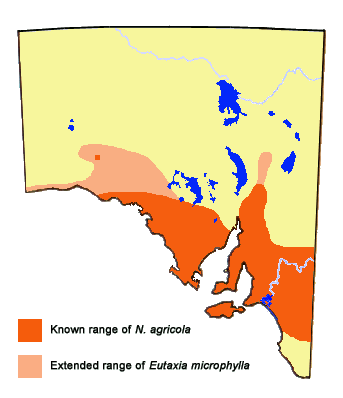
-
Habitat
-
In South Australia the distribution of the butterfly generally follows the distribution of
its preferred hostplant Eutaxia microphylla, which occurs mainly in mallee habitat
(dryland Eucalyptus woodland), coastal cliff-heath, and habitat on the dry side.
The butterfly prefers open habitat. It has yet to be been seen in the high rainfall
woodlands and forests in the Lower Southeast Region of the state (where its preferred
hostplant does not occur), although it is likely the butterfly will eventually be found
as bush-peas grow in the region. The butterfly can tolerate diverse climatic conditions,
from semi-arid to sub-alpine.
-
Conservation Status in South Australia
-
Uncommon to sometimes locally common, but widely distributed.
-
Threats
-
No major threats. Its mallee habitat is still widespread. The butterfly is only threatened
in areas of urbanisation and agricultural disturbances.
-
Conservation Strategy
-
None required. Its preferred hostplant is widespread and common in mallee remnants.
